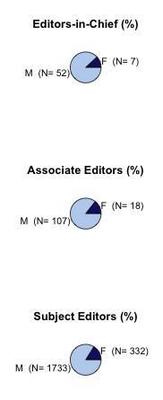The Backstory: Women are Underrepresented on Editorial Boards
Image: “Pen and Paper”, by Orin Zabest.
This semester I taught a 1-unit workshop on scientific publication for graduate students. As part of the workshop we studied how bias – geographic, institutional, gender, etc. – could influence the likelihood of getting published.
In all my grad classes I assign a group project, and this year’s was a follow-up to the discussion on bias. I asked students to review the gender composition of the editorial boards of 10 journals and see how well women were represented among the Subject Editors as well as the ‘editorial leadership’ (i. e., Associate Editors, Editors-in-Chief). This was actually something I’d started looking into last year with my former student Irina Skinner after the following twitter exchange with Jonathan Eisen:
.@phylogenomics we work hard for diversity of gender & geography on Biotropica's editorial board...hard but important. http://t.co/mChKKIb9— Emilio M. Bruna (@BrunaLab) January 17, 2013
@BrunaLab have you ever written anything about that? — Jonathan Eisen (@phylogenomics) January 18, 2013
@phylogenomics Haven't yet written about it but would like to. — Emilio M. Bruna (@BrunaLab) January 18, 2013
Irina and I never got around to finishing, so the students picked up where we left off and then expanded the project by adding several new journals and quantifying the editorial board composition all the way back to to 1985.
The results? The title of the post sums them up, but things appear to be getting better - least for some journals. You can read (and leave comments on) the manuscript we just submitted for publication and posted at the PeerJ Preprint server. But since you’ve gotten this far, I’ll leave you with one figure:
